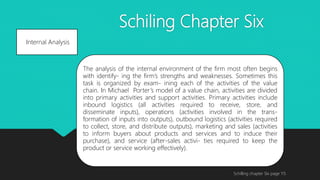
Chapter 6 porters value chain
- 1. Schiling Chapter Six Schilling chapter SIx page 115 Internal Analysis The analysis of the internal environment of the firm most often begins with identify- ing the firm’s strengths and weaknesses. Sometimes this task is organized by exam- ining each of the activities of the value chain. In Michael Porter’s model of a value chain, activities are divided into primary activities and support activities. Primary activities include inbound logistics (all activities required to receive, store, and disseminate inputs), operations (activities involved in the trans- formation of inputs into outputs), outbound logistics (activities required to collect, store, and distribute outputs), marketing and sales (activities to inform buyers about products and services and to induce their purchase), and service (after-sales activi- ties required to keep the product or service working effectively).
- 2. Schiling Chapter Six Schilling chapter SIx page 115 Internal Analysis Support activities include procurement (the acquisition of inputs, but not their physical transfer, as that would be covered in inbound logistics), human resource management (activities such as recruiting, hiring, training, and compensating personnel), technology devel- opment (activities involved in developing and managing equipment, hardware, soft- ware, procedures, and knowledge necessary to transform inputs into outputs), and infrastructure (functions such as accounting, legal counsel, finance, planning, public affairs, government relations, quality assurance, and general management necessary to ensure smooth functioning of the firm). This generic model can be adapted to bet- ter fit a particular firm’s needs. For example, for a biotechnology firm or software developer, research and development is likely to be a primary activity and inbound logistics may be insignificant.
- 3. Schiling Chapter Six Schilling chapter SIx page 116 Example of Value- Chain Analysis for Take2 Interactive Software Source: Adapted with the permission of The Free Press, a Division of Simon & Schuster Adult Publishing Group, from Competitive Advantage: Creating and Sustaining Superior Performance, by Michael E. Porter. Copyright © 1985, 1998 by Michael E. Porter.
- 4. Schiling Chapter Six Schilling chapter SIx page 115 Example of Value- Chain Analysis for Take2 Interactive Software
- 5. Schiling Chapter Six Schilling chapter SIx page 115 Example of Value- Chain Analysis for Take2 Interactive Software
- 6. Schiling Chapter Six Schilling chapter SIx page 118 Value Chain To be a potential source of sustainable competitive advantage, resources must be rare, valuable, durable, and inimitable.8 Resources that are rare and valuable may yield a competitive advantage, but that advantage will not be sustainable if the firm is incapable of keeping the resources, or if other firms are capable of imitating them. For example, a positive brand image can be a rare and valuable resource, but it requires ongoing investment to sustain. If a firm lacks the capital to reinvest in its brand image, it will erode. Furthermore, many valuable resources are quickly imi- tated by other firms.
- 7. Schiling Chapter Six Schilling chapter SIx page 118 Value Chain For exam- ple, if valuable resources are tacit (i.e., they cannot be readily codified in written form), path dependent (i.e., they are dependent on a particular historical sequence of events), socially complex (i.e., they arise through the complex interaction of mul- tiple people), or causally ambiguous (i.e., it is unclear how the resource gives rise to value), they will be extremely difficult to imitate.9 For example, talent is typically considered to be a tacit and causally ambiguous resource. It is thought to be an inher- ent trait that cannot be trained, and the mechanisms by which individuals acquire it or tap it are poorly understood. A first-mover advantage is a path-dependent advan- tage that cannot be copied—once a firm has become the first mover in a category, other firms no longer have the opportunity to be first. Once the firm has established a baseline internal analysis, it can move on to identifying its core competencies and formulate its strategic intent.
- 8. Schiling Chapter Six Schilling chapter SIx page 118 Value Chain LIFFIA JULIAN FAHRAI – SISTEM INFORMASI Tacit resources Resources of an intangible nature (such as knowl- edge) that cannot be readily codified. Socially complex resources Resources or activities that emerge through the interaction of multiple individuals. causal ambiguity The relation- ship between a resource and the outcome it pro- duces is poorly understood (the causal mechanism is ambiguous).
- 9. Schiling Chapter Six Schilling chapter SIx page 126 Summary Of Chapter 1. To analyze the internal environment, firms often begin by identifying strengths and weaknesses in each activity of the value chain. The firm can then identify which strengths have the potential to be a source of sustainable competitive advantage. 2. Next the firm identifies its core competencies. Core competencies are integrated combinations of abilities that distinguish the firm in the marketplace. Several core competencies may underlie each business unit, and several business units may draw upon the same core competency. 3. Sometimes core competencies can become core rigidities that limit the firm’s abil- ity to respond to a changing environment.